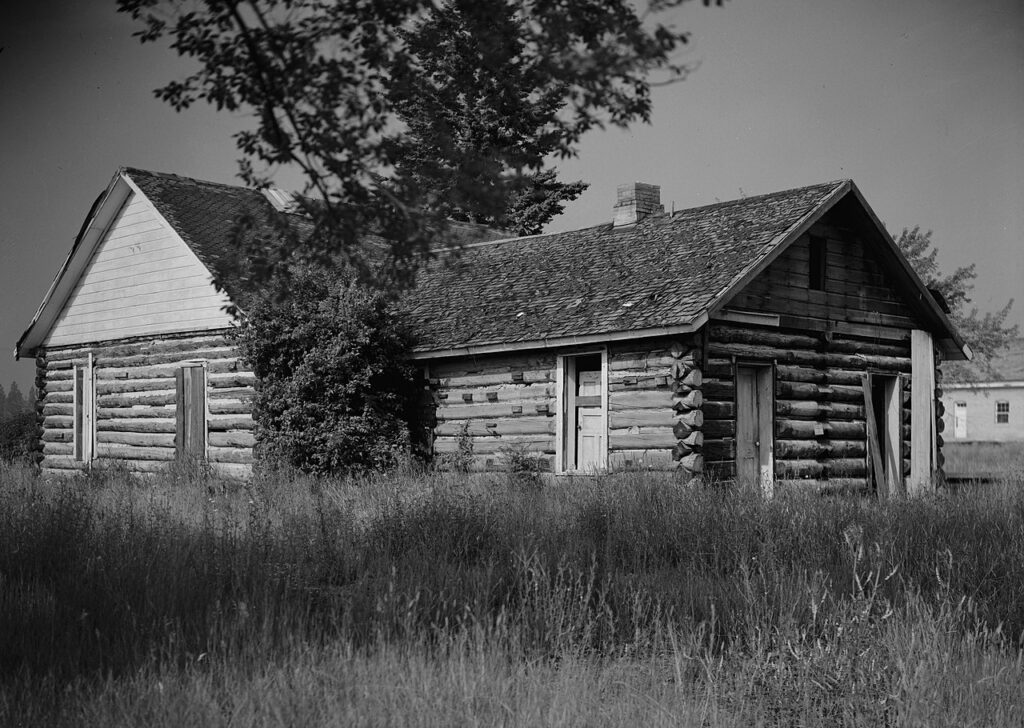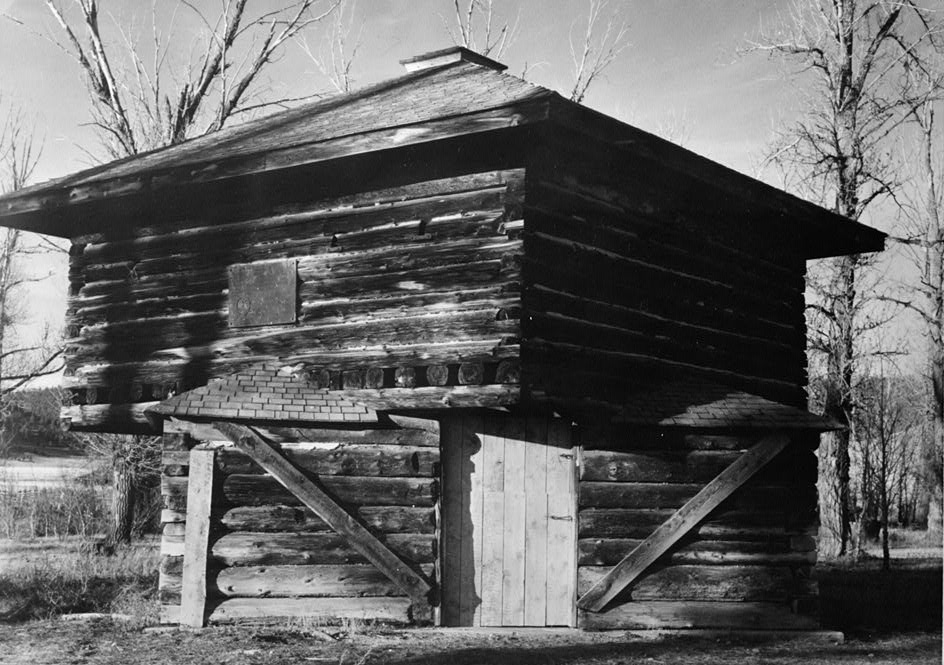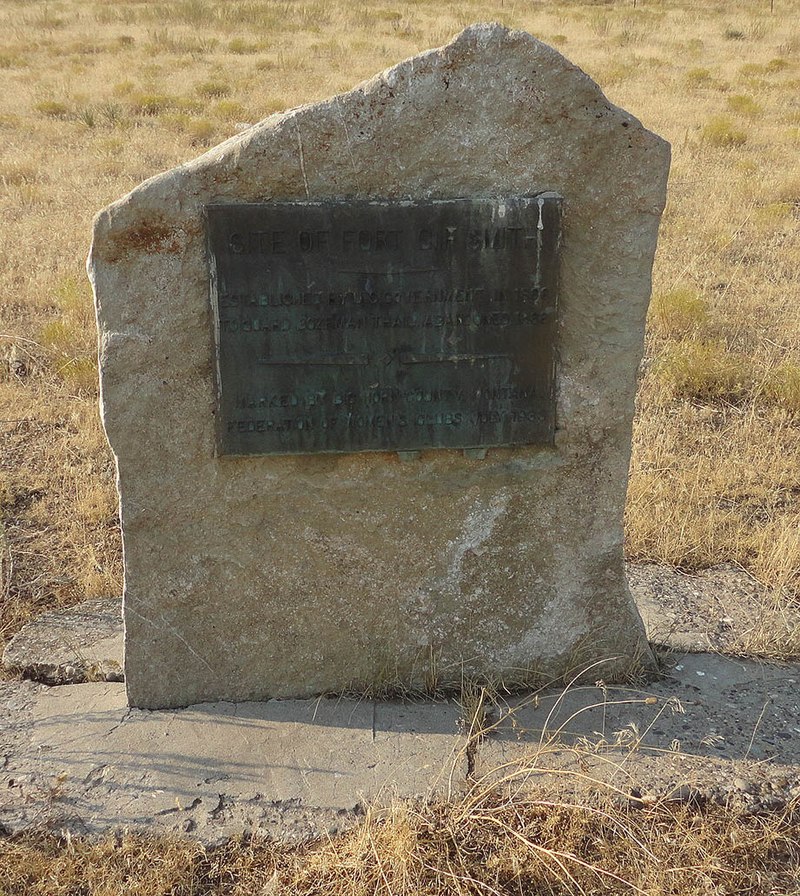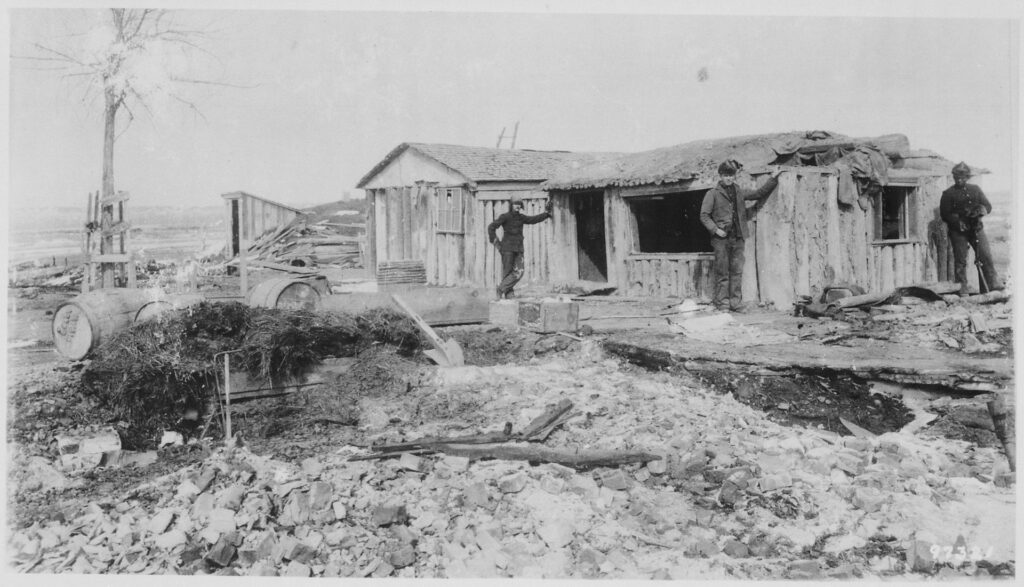Montana has a rich history. It is home to several historic forts. These forts were crucial in the region’s development and protection. The birthplace of Montana saw many forts supporting fur trading.
They observed the American frontier’s growth, interactions with Native Americans, and community development.
In this article historic forts in Montana, we will highlight sites like Fort Logan, Fort Lewis, and Fort Benton. All these forts trace back to Montana Territory’s early days.
10 Historic Forts in Montana
| 1. Fort Benton | 6. Fort Custer |
| 2. Fort Missoula | 7. Fort C.F. Smith |
| 3. Fort Peck | 8. Fort Shaw (Camp Reynolds) |
| 4. Fort Logan (Camp Baker) | 9. Fort Keogh |
| 5. Fort Lewis | 10. Fort Connah |
1. Fort Benton

Fort Benton, a significant landmark on the banks of the Missouri River, is frequently heralded as Montana’s cradle. Its foundation in 1846 marked it as a focal point for the vibrant fur trade, with Native Americans and fur traders frequently engaging in commerce.
The narrative of historic Fort Benton takes an intriguing turn in 1865. The allure of gold and the ensuing tensions of the Indian Wars prompted the United States Army to acquire the location. With haste, the once trading post morphed into a fortified military establishment, pivotal in shaping the region’s destiny.
Modern-Day Significance
In our contemporary era, Fort Benton is a testament to ancient times, and its architecture and legacy are beautifully preserved. As a designated National Historic Landmark, it invites countless visitors to delve into its illustrious past.
A highlight for many who journey to Fort Benton is the Museum of the Upper Missouri. Expert guides navigate visitors through the annals of history, elucidating on the fur trade era and military maneuvers. This immersive experience offers a tangible connection to those who once tread the same ground.
Shep: The Canine Guardian
Amidst tales of trade and tumult, a heartwarming narrative emerges. Shep, a loyal dog, stands as a symbol of the fort’s spirit. His story, recounted during the museum’s tours, evokes a mix of sentiment and admiration, reminding visitors of the enduring bonds formed during challenging times.
2. Fort Missoula

Situated amidst the rugged beauty of western Montana, Fort Missoula stands as a testament to the tumultuous Indian Wars era. The fort’s establishment in 1877 directly responded to the tensions and skirmishes that defined the period, serving as a stronghold and strategic outpost.
Buffalo Soldiers
Perhaps the Buffalo Soldiers were the most famed regiments stationed at Fort Missoula. These African American troops, belonging to the 25th Infantry Regiment, were pivotal in campaigns against the Nez Perce.
Under the leadership of their officers, including notable figures such as Lieutenant Henry O. Flipper, the first African-American graduate of West Point, they showcased exemplary courage and dedication.
Conflict with the Nez Perce:
The Nez Perce War (1877) was a significant military engagement for the fort. This conflict saw the Nez Perce tribe, led by Chief Joseph, resist relocation attempts by the U.S. government, resulting in a series of battles across the Northwestern United States.
Transition to Agricultural Research
Fort Missoula underwent a transformative phase by the early 20th century, with military confrontations dwindling. Montana State University took the reins, turning the fort into an agricultural experiment station.
This initiative aimed to harness Montana’s fertile grounds for farming research, which would eventually contribute to advancements in agronomy and sustainable farming practices.
Fort Missoula Today
Today, Fort Missoula is a proud bearer of military and agricultural history. Listed on the National Register of Historic Places, it is a beacon for history enthusiasts.
The fort’s robust architecture, with many original structures still intact, offers a tangible connection to the past. Summer months, in particular, see a surge in visitors eager to uncover tales of brave soldiers, Native American warriors, and groundbreaking agricultural experiments.
Visitors are encouraged to take guided tours, ensuring a comprehensive understanding of the fort’s multifaceted history, the notable figures who walked its grounds, and the significant events that unfolded within its walls.
3. Fort Peck
Nestled in northeastern Montana, Fort Peck traces its roots back to 1867. Emerging as a hub for fur traders and Native Americans, it stood as a testament to the bustling trade activity of the era.
However, Fort Peck’s significance was often overshadowed by its competitor, Fort Benton. Due to this rivalry and perhaps other undocumented events, the exact location of the original Fort Peck remains shrouded in mystery.
The Fort Peck Indian Reservation
As the years passed, the grounds that once bustled with traders and indigenous people evolved into the Fort Peck Indian Reservation.
This reservation, surrounded by the picturesque backdrop of the Rocky Mountains and the meandering Yellowstone River, serves as a home and cultural epicenter for various Native American tribes. It stands as a living testament to the indigenous heritage and its intertwining with the broader history of Montana.
Discovering Fort Peck’s Heritage Today
Although time and nature have taken their toll, erasing many of the original structures of Fort Peck, whispers of the past still linger. Visitors can marvel at the remnants of the fort’s walls, explore the enigmatic rocky point, and wander through the quaint town named in honor of the fort.
The Museum of the Northern Great Plains adds depth to the region’s historical tapestry. This institution and other small museums and sites weave together tales of early Montana life.
Through their exhibits and narratives, they shine a light on the dynamics of fur trading, the vibrant indigenous cultures, and the mosaic of events and personalities that left an indelible mark on the region.
Montana’s Trifecta: Benton, Missoula, and Peck
Forts Benton, Missoula, and Peck form a triad, offering a panoramic view into the mosaic of lives and events that sculpted Montana’s landscape. From fur traders and Native Americans to military personnel, their combined stories narrate the complex tale of the American West.
As guardians of history and natural splendor, these forts beckon history enthusiasts and nature lovers to unearth the myriad tales embedded in Montana’s soul.
4. Fort Logan (Camp Baker)

Camp Baker, named after Major Eugene M. Baker, emerged along the Smith River on November 1, 1869, as a vital military post in Montana’s diverse landscape.
The camp was later moved 10 miles to where the blockhouse sits now. Its primary function was safeguarding the Mullan Road, a critical transportation route during this era. This establishment ensured protection against potential threats and facilitated the westward movement and commerce.
Renaming and Expansion: Birth of Fort Logan
As the years passed, Camp Baker underwent a significant transformation in function and terminology. In the mid-1870s, in honor of General John A. Logan, a Civil War veteran and a key political figure, the camp was rechristened as Fort Logan.
This change was more than just symbolic; it reflected the post’s evolving role in the region and its growing strategic importance.
Architectural and Strategic Highlights
Fort Logan was equipped with the structures and facilities befitting a military outpost of its stature. The iconic blockhouse, a significant defensive structure, is a testament to the fort’s readiness to repel potential threats. It encapsulated the essence of the challenges and responsibilities shouldered by the personnel stationed there.
Decommissioning and Legacy
Despite its significance, Fort Logan’s active years were relatively brief. By the late 19th century, it was decommissioned, ending its direct military involvement in the region. However, its legacy lived on. The fort’s remnants, particularly the blockhouse, symbolized Montana’s rich military history.
Today, Fort Logan invites historians, tourists, and locals alike to step back in time. The sturdy walls of the blockhouse and the fort’s sparse remains narrate tales of military diligence, the challenges of frontier life, and the ceaseless march of progress. It is a poignant reminder of the sacrifices and endeavors that have shaped Montana’s history.
5. Fort Lewis
Established in the 1830s, Fort Lewis was a fur trading post located on the Yellowstone River in Montana.
It was part of the broader network of trading posts that sprouted up in the region during the 19th century, catering to the robust fur trade between Native Americans and European settlers.
While not as enduringly famous or as long-lasting as some other forts in Montana, Fort Lewis played a role in the economic and social fabric of the region during its operational years.
As with many fur trading posts of the time, it would have been a hub of activity and commerce, facilitating exchanges between different cultures and serving as a nexus of interaction in the frontier environment.
Over time, as the fur trade waned and Montana underwent significant changes, the importance of places like Fort Lewis diminished. However, its existence and operation are essential in the broader mosaic of Montana’s historical landscape, providing a glimpse into the economic and cultural dynamics of the region during the 19th century.
6. Fort Custer

In central Montana, as the American West faced the throes of the Indian Wars, Fort Custer emerged as a symbol of military might and strategic planning.
Recognizing the pressing need to establish a fortified position, the U.S. military erected Fort Custer to navigate and manage the intensifying conflict between Native American tribes and the advancing American frontier.
Ideally positioned, Fort Custer was situated at the confluence of the Big Horn and Little Big Horn Rivers, offering a strategic vantage point. This riverside locale facilitated ease of transportation and communication and ensured the fort could effectively oversee and control significant portions of the territory.
Fort Custer’s Role in the Frontier
Beyond merely being a defensive stronghold, Fort Custer played a multifaceted role in the American West. As a hub of military activity, it hosted numerous regiments, provided logistical support, and served as a coordination center for various military campaigns.
Its establishment played a pivotal role in the resettlement and relocation efforts post the Battle of Little Bighorn, facilitating the transition from a conflict-torn landscape to a more organized American frontier.
While the drums of the Indian Wars have long been silenced, Fort Custer’s legacy stands resilient. Its remnants are a solemn reminder of the era’s challenges, confrontations, and eventual transformations.
The fort symbolizes a critical juncture in American history, where cultures clashed, negotiations were brokered, and a new societal fabric was woven.
7. Fort C.F. Smith

Established during the 1860s on the banks of the Bighorn River, the fort was initially dubbed Fort Ransom. However, in recognition of General Charles Ferguson Smith’s outstanding military service and leadership during the Civil War, the fort was soon renamed Fort C.F. Smith.
General Smith, known for his strategic insight and unwavering dedication, became the fort’s namesake, forever linking his legacy to this significant Montana landmark.
Fort’s Strategic Role on the Bozeman Trail
Nestled within the boundaries of the present-day Crow Indian Reservation, Fort C.F. Smith held a crucial position along the Bozeman Trail, a historic travel route.
This trail, serving as a primary corridor for settlers venturing towards Montana’s gold-laden regions, necessitated fortified protection, given the intensifying friction between settlers and indigenous tribes.
A Landscape of Confrontation and Defense
Throughout its operational years, Fort C.F. Smith was no stranger to confrontations. The fort was subjected to numerous indigenous attacks, notably by the Lakota Sioux and Cheyenne warriors, who opposed the U.S. military’s presence and the continuous flow of settlers through their ancestral lands.
These skirmishes underscored the broader conflict over territory, resources, and cultural preservation.
Key Figures and Moments
While General Charles Ferguson Smith‘s name graced the fort, several prominent individuals played crucial roles in its history. Military personnel there, from rank-and-file soldiers to commanding officers, faced the daunting task of defending the fort and maintaining peace in a region simmering with tensions.
The fort’s proximity to significant events, such as the Fetterman Fight in 1866, further highlighted its role in the volatile dynamics of the frontier.
Legacy Amidst the Crow Lands
Today, while the fort’s active operations have long ceased, its historical remnants on Crow territory are a poignant reminder of a turbulent era. Fort C.F. Smith is a testament to the struggles, negotiations, and confrontations that molded the American West.
Visitors are invited to reflect on the intricate tapestry of stories as they traverse its grounds, from the military strategies crafted within the fort’s walls to the valiant indigenous resistance outside them.
8. Fort Shaw (Camp Reynolds)
Initially erected in the early 1860s near the Sun River’s serene banks, the military installation was first christened as Camp Reynolds. This title, however, was short-lived.
In honor of Colonel Robert Shaw, a distinguished Union officer renowned for commanding the all-African American 54th Massachusetts Infantry Regiment during the Civil War, the camp was soon rebranded as Fort Shaw.
Fort Shaw’s establishment was a strategic move, catering to the needs of settlers journeying through the Montana Territory. As the American frontier expanded, the fort played a crucial role in ensuring the safety of these pioneers while facilitating communication and transportation networks in the region.
Clashes, Confrontations, and Diplomacy
The landscape surrounding Fort Shaw was fraught with tensions. Native American tribes, primarily the Blackfeet, viewed the continuous influx of settlers and the increasing military presence skeptically.
This often led to confrontations, demanding military tact and diplomatic negotiations from the fort’s occupants. Balancing defense with efforts to maintain peace, Fort Shaw became a hub of interaction between indigenous communities and U.S. military personnel.
Prominent Personalities and Moments
Beyond Colonel Robert Shaw’s posthumous recognition through the fort’s naming, several influential figures graced its corridors. Commanding officers, enlisted soldiers, and diplomatic envoys stationed at Fort Shaw faced the challenge of safeguarding the fort while navigating the complex socio-political fabric of the frontier.
Legacy on Montana’s Plains
Though the bugles and drums at Fort Shaw have long fallen silent, their legacy remains vivid.
Today, the fort’s remnants are a powerful reminder of Montana’s rich history — an era of exploration, conflict, and transformation. As visitors explore the site, they are transported back to a time of frontier challenges, military endeavors, and the intricate dance of diplomacy and strategy.
9. Fort Keogh

Emerging in the aftermath of the pivotal Battle of Little Bighorn in 1876, Fort Keogh played a defining role in the U.S. military’s frontier strategies.
Located at the confluence of the Yellowstone and Tongue Rivers, its establishment aimed to bolster American dominance in the region, marking a response to the growing challenges posed by indigenous resistance.
The fort’s nomenclature pays homage to Captain Myles Keogh, an Irish-born officer who bravely served with the 7th Cavalry and met his end at the Battle of Little Bighorn. His dedication and bravery were posthumously recognized, immortalizing his name through the fort’s designation.
Safeguarding Montana’s Expansive Frontier
Fort Keogh wasn’t merely a military installation but a linchpin in the U.S. government’s efforts to assert control over Montana’s vast frontier territories.
The fort witnessed frequent interactions with indigenous tribes, most notably the Northern Cheyenne and Sioux, with its occupants continually striving to maintain a delicate balance between defense, diplomacy, and cultural mediation.
Eminent Figures and Noteworthy Incidents
While Captain Myles Keogh’s memory casts a long shadow over the fort, numerous other figures also played pivotal roles in its history. Fort Keogh became a melting pot of diverse personalities and experiences, from seasoned cavalrymen to intrepid scouts and skilled negotiators.
Their collective efforts shaped the fort’s legacy, as they confronted challenges ranging from harsh winters to intricate tribal negotiations.
From Military Stronghold to Agricultural Hub
Fort Keogh evolved as the decades rolled on and the frontier era waned. While its military significance was reduced, it found a renewed purpose as an agricultural research station.
This transformation underscores the adaptability and resilience of the American West — a land that constantly reshapes its identity while honoring its past.
Preserving Memories of the Montana Frontier
Today, Fort Keogh is a testament to a tumultuous period in American history. Its walls, though silent, reverberate with tales of courage, conflict, and coexistence.
While meandering through the remnants of the fort, visitors are invited to reflect on the myriad stories and personalities that shaped the narrative of Montana and the broader frontier landscape.
10. Fort Connah

Within Montana’s picturesque Flathead Valley, Fort Connah is a reminder of the region’s vibrant trading history. Established in 1846, this trading post was primarily an initiative of the renowned Hudson’s Bay Company, marking their westernmost outpost within U.S. territory.
The fort derived its name from Dr. William Connah, a significant figure associated with the Hudson’s Bay Company. Dr. Connah’s involvement and contributions to the region’s fur trade industry solidified his legacy, leading to the fort being named in his honor.
A Hub of Commerce and Diplomacy
Fort Connah wasn’t just a mere trading post; it represented a nexus of commerce and cultural exchange in the Montana territory. Indigenous tribes, notably the Salish and Kootenai, regularly interacted with European traders at the fort, leading to a rich tapestry of trade, negotiations, and mutual respect.
Key Personalities and Defining Moments
The fort’s history is replete with tales of intrepid traders, skilled negotiators, and indigenous leaders who played integral roles in shaping its legacy. Their combined efforts ensured Fort Connah wasn’t just a commercial hub and a melting pot of diverse cultures and traditions.
As the fur trade era began its decline and the U.S. government’s influence in the region grew, Fort Connah underwent a series of transformations. Despite facing challenges, its significance as a symbol of early Montana commerce and diplomacy persisted.
Echoes of the Past in the Present
Today, the remnants of Fort Connah serve as a poignant reminder of a bygone era. The fort’s enduring structures, some of which are among the oldest standing buildings in Montana, transport visitors back to a time of bartered goods, shared stories, and the forging of alliances.
As one traverses the grounds of Fort Connah, they’re invited to delve deep into the stories, experiences, and interactions that collectively forge the rich history of Montana’s Flathead Valley.
Related: 10 Historic Forts in Nebraska
Conclusion – Historic Forts in Montana
Montana, a state replete with vast landscapes and rich history, offers a unique tapestry of historic sites that chronicle the tales of its past. The trading forts, which once bustled with bartered goods and tales from distant lands, stand as testaments to the early days of commerce and diplomacy.
Montana’s military forts, on the other hand, echo the strategies, confrontations, and alliances of an era marked by expansion and change. Among these sites, some structures boast the title of Montana’s oldest buildings, serving as silent witnesses to the state’s dynamic evolution.
These historic gems provide invaluable insights into Montana’s socio-cultural and economic fabric, inviting visitors and locals alike to appreciate and explore the intricate stories embedded within their walls.
We would love to hear from you if you have visited any of these forts. Just leave a comment below and tell us about your experience.

Cory is a website owner and content creator who enjoys fishing, history, coin collecting, and sports, among other hobbies. He is a husband and father of four.
Romans 15:4 For whatever was written in former days was written for our instruction, that through endurance and through the encouragement of the Scriptures we might have hope.

